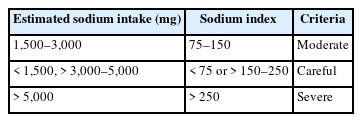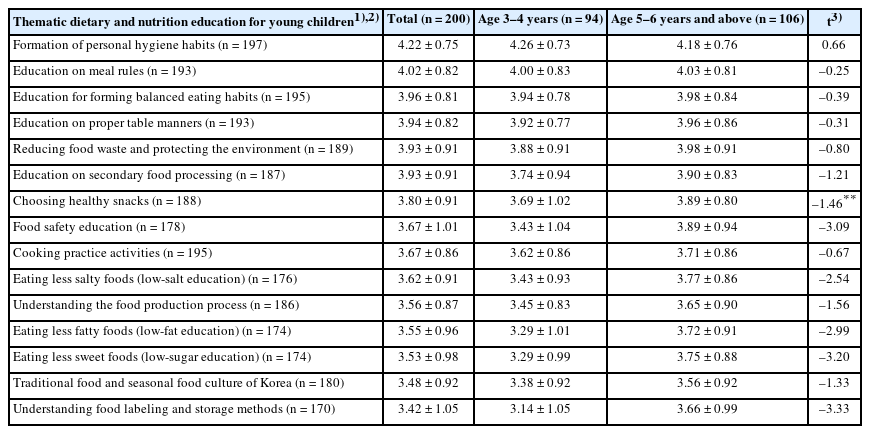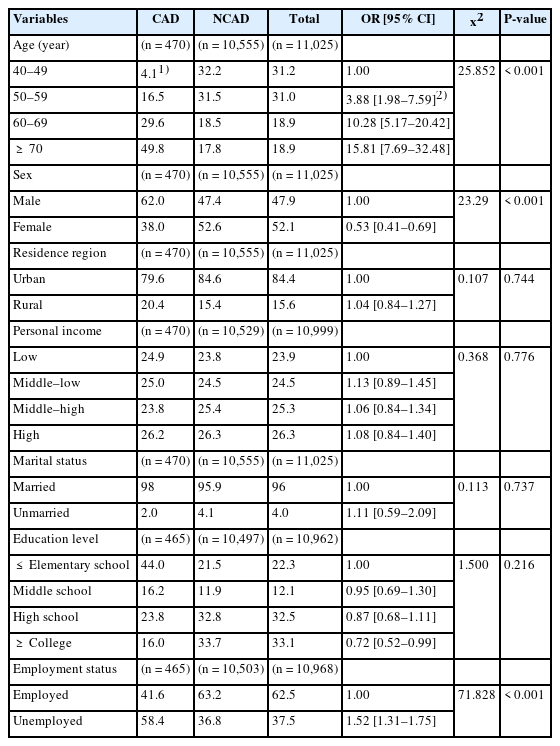Current issue
- Page Path
- HOME > Browse Articles > Current issue
Review
- [English]
- Dietary factors and nutritional guidelines for sarcopenia in older adults: a narrative review
- Sumin Heo, Soo Jin Yang
- Korean J Community Nutr 2025;30(6):389-396. Published online December 31, 2025
- DOI: https://doi.org/10.5720/kjcn.2025.00360

-
 Abstract
Abstract
 PDF
PDF - Objectives
Sarcopenia is a condition characterized by the loss of muscle mass and function and is often accompanied by aging and chronic diseases such as diabetes and obesity. It increases the risk of falls, frailty, disability, hospitalization, and mortality in older adults. Its global prevalence is estimated as approximately 10%–27% in adults aged > 60 years. This review analyzes evidence from research findings and recommendations to provide a comprehensive overview of dietary factors and nutritional strategies for preventing and managing sarcopenia in older adults.
Methods
Literatures were searched to integrate findings from observational studies, clinical trials, systematic reviews, and meta-analysis on dietary factors and nutritional guidelines for the prevention and management of sarcopenia. Particularly, points were emphasized on protein intake, micronutrient adequacy, dietary patterns, and combined lifestyle interventions relevant to older populations.
Results
Sarcopenia develops through multifactorial mechanisms such as dysfunction in muscle protein synthesis, chronic inflammation, mitochondrial dysfunction, and aging-related hormonal decline. Nutritional factors, particularly protein intake, play a central role in its development and management. Adequate protein intake is typically 1.0–1.2 g/kg/day for healthy older adults and more than 1.2 g/kg/day for individuals with sarcopenia or frailty. High-quality protein intake, sufficient leucine intake, and amino acids or β-hydroxy-β-methylbutyrate supplementation may help to counteract dysfunction in muscle protein synthesis. The adequacy of vitamin D supports musculoskeletal health. Dietary patterns, such as the Mediterranean and Dietary Approaches to Stop Hypertension diets have been consistently associated with better muscle mass, strength, and function. Strong evidence has demonstrated synergistic benefits when optimized nutrition is combined with resistance exercise.
Conclusion
The comprehensive management of sarcopenia in older adults requires an integrated strategy that prioritizes adequate protein and energy intake, vitamin D adequacy, healthy dietary patterns, and regular resistance exercise.
- 253 View
- 14 Download

Research Articles
- [English]
- Nutrition Quotient and nutrient intake among older adults in a rural Korean community: a cross-sectional study
- Ji-Sook Park, Hyeon-Mi Bae, Jung-Eun Yim
- Korean J Community Nutr 2025;30(6):397-409. Published online December 31, 2025
- DOI: https://doi.org/10.5720/kjcn.2025.00283

-
 Abstract
Abstract
 PDF
PDF - Objectives
Korea is experiencing rapid population aging, with older adults forming a large proportion of rural communities. Aging leads to physiological and functional declines, resulting in lower physical activity, poor diet quality, and higher risk of chronic diseases. Although the Nutrition Quotient for the Elderly (NQ-E) is a validated tool to assess dietary quality, few studies have applied it to rural populations. This study aimed to compare nutrient intake and NQ-E scores by age and sex and examine their associations with lifestyle factors.
Methods
This study investigated the relationship between nutrient intake and NQ-E scores among older adults in rural Korean community, considering age, sex, and lifestyle factors. A cross-sectional study was conducted with 79 community-dwelling older adults (24 male and 55 female; mean age: 76.3 years) residing in Geochang-gun, Gyeongsangnam-do, Korea. Participants were recruited from community centers and health posts between June 2024 and December 2024. Data collection included general characteristics, 24-hour dietary recalls, and NQ-E questionnaires.
Results
Female aged > 75 years had significantly lower intakes of energy, protein, fat, vitamin E, riboflavin, folate, and zinc than their male counterparts (P < 0.05). The mean NQ-E score was 55.01, which was lower than the national average reported for urban older adults (57.6). Participants with higher NQ-E grades had significantly higher intakes of dietary fiber, vitamin A, thiamine, riboflavin, niacin, potassium, and magnesium, and regular physical activity and dietary supplement use were positively associated with higher NQ-E grades (P < 0.01).
Conclusion
These findings suggest that older female in rural communities are particularly vulnerable to inadequate nutrient intake and lower dietary quality, and that the NQ-E is a useful screening tool for identifying nutritional risk in this population. Community-based nutrition interventions promoting physical activity, supplement use, and dietary diversity are warranted to improve dietary quality and support healthy aging.
- 101 View
- 9 Download

- [English]
- Ultra-processed food intake and dietary behaviors in Korean adolescents: a cross-sectional study based on the 2019–2023 Korea National Health and Nutrition Examination Survey
- Jin-A Kim, Sim-Yeol Lee
- Korean J Community Nutr 2025;30(6):410-418. Published online December 31, 2025
- DOI: https://doi.org/10.5720/kjcn.2025.00297

-
 Abstract
Abstract
 PDF
PDF - Objectives
This study aimed to investigate the intake of ultra-processed foods (UPF) and dietary behaviors in Korean adolescents.
Methods
This study used 24-hour dietary recall data from the Korea National Health and Nutrition Examination Survey (2019–2023). In total, 1,720 adolescents aged 12–18 years were included in this study and categorized into quartiles based on the percentage of energy intake from the UPF. Nutritional status, contributing subgroups of UPF intake, and healthy dietary practices were examined using Health Plan 2030 indicators across quartiles of UPF intake.
Results
The nutrient intake of protein, vitamins (A, B1, B2, niacin), and minerals (iron, potassium) was the lowest in the fourth quartile of UPF intake compared with the first quartile (P for trend < 0.001), whereas calcium intake increased across quartiles, from 47.68% in the first quartile to 58.51% in the fourth quartile (P for trend < 0.001). The main contributing subgroups to UPF intake differed across quartiles of UPF intake, and the highest contributing subgroups were ‘instant noodles and dumplings,’ ‘desserts, cakes, and ice cream,’ and ‘sauces and seasonings.’ Healthy dietary practices were the lowest in the fourth quartile (22.18%, P < 0.001), and the proportions of appropriate fat and fruit/vegetable intake were significantly lower in the higher quartiles of UPF intake (P < 0.001).
Conclusion
This study suggests that a lower UPF intake was associated with better nutritional status and healthy dietary practices in Korean adolescents. These findings provide fundamental evidence for promoting healthier food choices and balanced dietary practices.
- 165 View
- 9 Download

- [English]
- The association between sodium index and the risk of obesity in Korean and Chinese university students: a cross-sectional study
- Linan Wang, Jin-Ah Seok, Yeon-Kyung Lee
- Korean J Community Nutr 2025;30(6):419-430. Published online December 31, 2025
- DOI: https://doi.org/10.5720/kjcn.2025.00318

-
 Abstract
Abstract
 PDF
PDF Supplementary Material
Supplementary Material - Objectives
Korea and China have the highest sodium intakes globally. The sodium index is a quantitative measure of the estimated sodium intake, calculated using a regression equation with proven validity and reliability in individuals aged 19–69 years. This study aimed to compare the sodium index of Korean and Chinese university students and analyze the association between the sodium index and the risk of obesity.
Methods
A total of 218 university students—110 Korean (63 males, 47 females) and 108 Chinese (60 males, 48 females)—participated in this study in 2019. Sodium-related awareness, nutritional knowledge, and sodium index were compared between Korean and Chinese students. Obesity indicators were compared according to three criteria for the sodium index of Korean and Chinese students: “moderate,” “careful,” and “severe. ” The association between sodium index levels and risk of obesity was analyzed using multiple logistic regression analysis adjusted for age and sex.
Results
Overall, 84% of students recognized that they consumed large amounts of sodium. Korean students demonstrated higher nutritional knowledge scores than Chinese students. The average estimated sodium intake was 3,751 mg, and no significant difference was observed between Korean (3,857 mg) and Chinese (3,643 mg) students. The overall average sodium index was 187, which falls under the “careful” level. As the sodium index levels increased, the students’ body mass index, waist-hip ratio (WHR), and fat-related indicators significantly increased. At the “severe” level of the sodium index, Korean and Chinese students had 2.402-fold and 1.636-fold increases in the risk of obesity based on body fat percentage, and 3.682-fold and 1.622-fold increases based on WHR, respectively.
Conclusion
This study demonstrated an association between sodium index and obesity risk, showing that excessive sodium intake affects body fat-related indicators in university students.
- 117 View
- 9 Download

- [Korean]
- Toward the development of a digital self-nutrition management education program for elderly: findings from focus groups study
- Hae-song Yoo, Jin-myong Lee, Min-sun Jeon
- Korean J Community Nutr 2025;30(6):431-440. Published online December 31, 2025
- DOI: https://doi.org/10.5720/kjcn.2025.00234

-
 Abstract
Abstract
 PDF
PDF - Objectives
The aim of this qualitative study was to explore and understand the behaviors and challenges of self-nutrition management from the perspective of elderly.
Methods
In May 2025, ten elderly aged 65–83 years with prior experience using digital devices were recruited through purposeful sampling. Data were collected via focus group interviews using a semi-structured questionnaire until saturation was reached, and all interviews were recorded, transcribed, and analyzed using traditional content analysis methods. The collected interview data were extracted focusing on phrases or sentences relevant to the research purpose, and various concepts derived through memo writing and the constant comparison were categorized based on common meanings. Subsequently, the categorized statements were deeply interpreted and reclassified into subcategories for final analysis.
Results
Under the overarching theme of development directions for a digital self-nutrition management education program for elderly, three main categories and 13 subcategories were derived. The three main categories include: (1) processes of acceptance and utilization of digital technologies; (2) potential for applying digital self-nutrition management; and (3) strategies for implementing digital-based nutrition education.
Conclusion
Our findings indicate that elderly face barriers to utilizing digital tools for self-nutrition management not only due to physical or technical limitations, but also because of the confusion arising from limited nutrition knowledge and information overload. To overcome the barriers that may arise during the digital-based education process for elderly, strategies (educational topics, delivery strategies, and operational strategies) were derived to vitalize a digital self-nutrition management education program. These results highlight the necessity of developing tailored digital nutrition education programs that reflect the characteristics of elderly, which may enhance their practical applicability and provide foundational evidence for establishing a digital–nutrition integrated care model within the senior customized care service.
- 132 View
- 16 Download

- [Korean]
- Parents' needs and perceptions of dietary and nutrition education in early childhood education institutions in South Korea: a mixed methods study
- Jounghee Lee, Sookyung Choi, Minseo Kim, Seonghyun Lim, Jeong-Weon Kim
- Korean J Community Nutr 2025;30(6):441-456. Published online December 31, 2025
- DOI: https://doi.org/10.5720/kjcn.2025.00304

-
 Abstract
Abstract
 PDF
PDF - Objectives
This study aimed to clarify parental perceptions of dietary and nutritional education provided to young children, identify parental support needs, and suggest directions for improvement.
Methods
A mixed-method sequential explanatory design was followed. Quantitative data were collected through an online survey conducted nationwide that included 200 parents of children aged three to six years in South Korea. Qualitative data were subsequently obtained through focus group interviews with fifteen parents to explore their contextual insights and experiences.
Results
Needs ratings prioritized expanding activity-based/experiential education (3.65 ± 0.88), followed by strengthening home-school communication and connectivity (3.59 ± 0.84), diversifying topics and content (3.55 ± 0.88), and increasing instructional time (3.39 ± 0.94). Integrated with the focus group interview findings, multilevel barriers were revealed—individual level: strong preferences of children for sweet/processed foods; interpersonal level: strong parental modeling and peer effects counterbalancing limited teacher expertise/time; organizational level: insufficient effective event-based experiential activities, and resource gaps across institutions; community/policy level: infrequent external support, uneven access to local resources, lack of standardized guidance, and limited opportunities for parental participation. Parents favored short, interactive digital content and expressed concerns about overexposure. These convergent findings indicate needs to 1) formalize and extend experiential programs within the regular curriculum, 2) provide standardized guidelines and home resource kits, and 3) institutionalize parental involvement.
Conclusion
These findings reveal that dietary and nutritional education for young children should move beyond fragmented, event-based programs toward an integrated three-tiered model incorporating (1) a structured, experiential curriculum, (2) home-linked educational packages, and (3) safe and interactive digital content. Establishing standardized guidelines, enhancing educational infrastructure, and institutionalizing parental participation are essential for sustainable improvement of early childhood dietary education.
- 118 View
- 7 Download

- [Korean]
- Prevalence of coronary artery disease according to lifestyle characteristics, nutrient intake level, and comorbidities among Koreans aged 40 years and older: a cross-sectional study using data from the 7th (2016–2018) Korea National Health and Nutrition Examination Survey
- Areum Song, Sook-Bae Kim
- Korean J Community Nutr 2025;30(6):457-470. Published online December 31, 2025
- DOI: https://doi.org/10.5720/kjcn.2025.00346

-
 Abstract
Abstract
 PDF
PDF - Objectives
To examine the prevalence of coronary artery disease (CAD) according to lifestyle characteristics, nutrient intake level, and comorbidities among Koreans aged 40 years.
Methods
Data were derived from 11,025 participants aged ≥ 40 years in the 7th Korea National Health and Nutrition Examination Survey. Participants were assigned to a CAD group (n = 470) or a non-CAD group (n = 10,555). Socio-demographic characteristics (age, sex, residence, income, marital status, education level, and employment status), lifestyle characteristics (smoking, drinking, walking, strength training, sleep duration, stress level, and subjective health perception), energy and nutrient intakes, and comorbidities, including obesity, hypertension, dyslipidemia, diabetes mellitus, stroke, cancer, depression, renal failure, cataract, asthma, chronic obstructive pulmonary disease, osteoarthritis, and osteoporosis were analyzed.
Results
The prevalence of CAD was higher in older participants and in male. Participants with CAD had higher rates of smoking, engaged in less strength training, experienced higher stress, and had poorer perceived health. They had lower intakes of energy, fiber, folate and iron. The prevalence of obesity, hypertension, dyslipidemia, diabetes mellitus, stroke, depression, renal failure, cataract, asthma, allergic rhinitis, osteoarthritis, or osteoporosis was significantly higher in the CAD group. The likelihood of having CAD was significantly higher among participants with renal failure (odds ratio [OR], 4.25; 95% confidence interval [CI], 2.24–8.08), depression (OR, 2.14; 95% CI, 1.55–2.95), asthma (OR, 2.07; 95% CI 1.48–2.91), and dyslipidemia (OR, 2.03; 95% CI, 1.69–2.44).
Conclusion
In Koreans aged 40 years, CAD was associated with unhealthy lifestyle habits, low nutrient intake, and increased comorbidities such as renal failure, depression, asthma, and dyslipidemia. These findings suggest the need for lifestyle management and intensive chronic disease management to reduce the risk of CAD.
- 96 View
- 10 Download

Educational Material
- [Korean]
- Development and evaluation of play-based food and nutrition education materials for early childhood through sensory experiences: a pre-post observational study
- Hyunjoo Ryou, Sohyun Park, Jieun Oh, Ji-Yun Hwang
- Korean J Community Nutr 2025;30(6):471-483. Published online December 31, 2025
- DOI: https://doi.org/10.5720/kjcn.2025.00276

-
 Abstract
Abstract
 PDF
PDF - Objectives
This study aimed to develop play-based nutrition education (PBNE) materials for young children and to evaluate their applicability and effectiveness.
Methods
An online survey of 1,253 primary caregivers of preschool children was conducted, and the findings were used to develop age-specific utilization guides, slides, activity sheets, activity cards, posters, educational videos, and parent newsletters. Selected materials were implemented in child-care centers through the Children’s Foodservice Management Centers between October and November 2023. The effectiveness of the PBNE program was assessed by examining changes in mushroom consumption as well as food awareness and preferences, before and after the intervention.
Results
A total of eight media formats and 320 educational contents were developed, and mushrooms were as the pilot theme among the 12 possible food items. Following the intervention, children’s positive awareness of mushrooms increased, and > 96% of participants attempted to consume them. Teachers in child-care centers rated the appropriateness and applicability of the content, its contribution to behavioral improvement, and their overall satisfaction at > 4.9 out of 5 points.
Conclusion
This study developed experiential, PBNE materials aligned with the national standard child- and play-centered curriculum. The materials were effective in enhancing food awareness and promoting attempts at consumption. Future efforts should focus on developing additional experiential teaching tools that incorporate teacher feedback and on strengthening home-linked programs to support healthy seasonal food intake and positive dietary experiences in young children.
- 127 View
- 9 Download


 KSCN
KSCN


 First
First Prev
Prev



